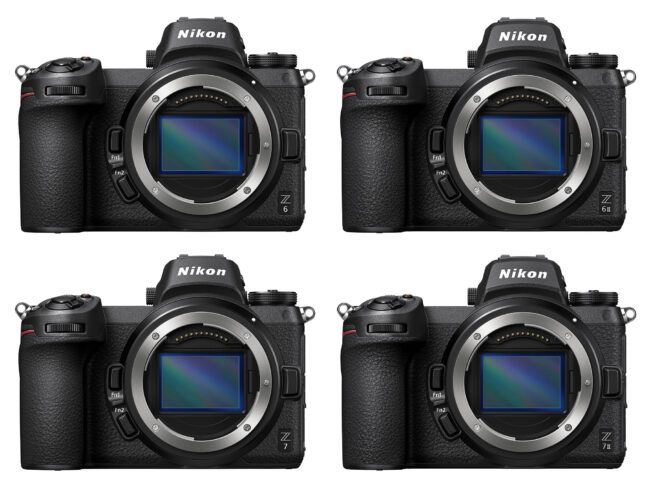
This article is a bird’s eye view of all Nikon Z products available at the moment, including cameras, lenses, and official accessories. My hope is that photographers considering a Nikon Z camera will find this a helpful guide to figure out what equipment is out there.
While this article only covers Nikon-brand products for the Z system, there are numerous compatible third-party lenses which I will cover in a future article.
I’ll be updating this guide as new products are announced for the Z system so that it always remains as current as possible.
Nikon Z Cameras
There are seven Nikon Z cameras available for purchase at the moment, as well as one Nikon Z camera that has been pre-announced but will not ship until late 2021. I’ll go through them briefly below.
All Nikon Z cameras so far have one of two sensor sizes: an aps-c sensor with a 1.5x crop factor (which Nikon calls DX cameras) and a standard full-frame sensor (which Nikon calls FX cameras). DX cameras are generally smaller, lighter, and less expensive than FX cameras. However, they do have some drawbacks in dynamic range and high ISO performance because of the smaller sensor. See Nikon DX vs FX.
I’ll start by listing the DX cameras below.
DX (1.5x Crop Sensor) Cameras
Nikon Z50
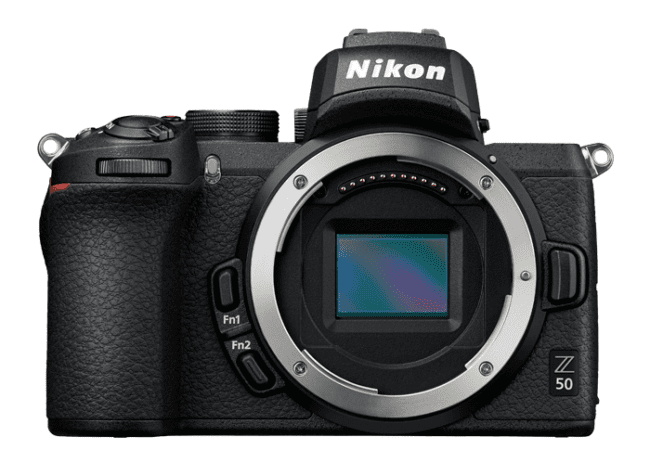
- Announced: November 2019
- Sensor size: DX
- Resolution: 20.9 megapixels
- Autofocus system: 209-point hybrid PDAF
- Frame rate: 11 FPS
- Base ISO: 100
- LCD type: Tilting touchscreen
- Max video specs: 3840×2160 (4k), 30p
- Battery life: 300 photos
- Control layout: Low to mid-range
- Memory cards: 1 SD (UHS-I compatible)
- Weight w/ battery and card: 450 g (0.99 lbs)
- Dimensions (W×H×D): 127 × 94 × 60 mm (5.0 × 3.7 × 2.4 in.)
- Price at launch: $860; check current price
The Nikon Z50 is a 21-megapixel “upper entry level” mirrorless camera with surprisingly good specifications. It shoots 11 frames per second stills as well as 4K video, and it has eye-tracking autofocus (including some animal eyes) for portraits and wildlife photography. However, it lacks a few features found on Nikon’s more advanced mirrorless cameras, such as dual card slots, in-body image stabilization, and an AF-On button – and, of course, it has the smaller DX sensor.
Read our Nikon Z50 review for more.

Nikon Zfc
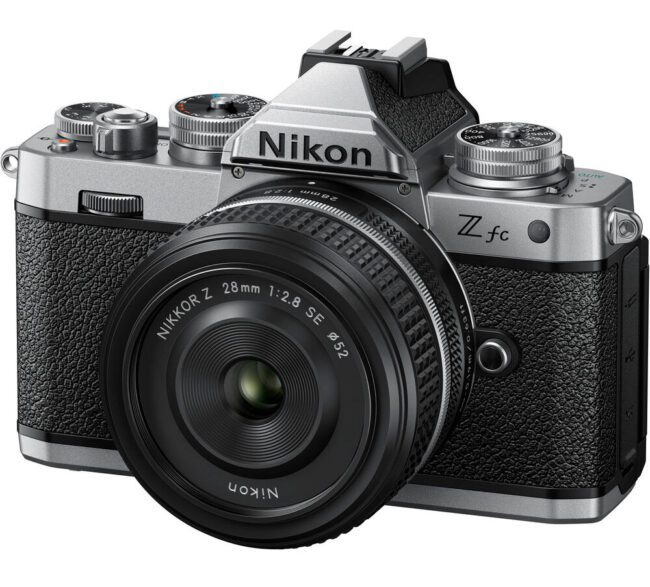
- Announced: June 2021
- Sensor size: DX
- Resolution: 20.9 megapixels
- Autofocus system: 209-point hybrid PDAF
- Frame rate: 11 FPS
- Base ISO: 100
- LCD type: Fully articulating touchscreen
- Max video specs: 3840×2160 (4k), 30p
- Battery life: 300 photos
- Control layout: Retro
- Memory cards: 1 SD (UHS-I compatible)
- Weight w/ battery and card: 445 g (0.98 lbs)
- Dimensions (W×H×D): 135 × 94 × 44 mm (5.3 × 3.7 × 1.7 in.)
- Price at launch: $960; check current price
The Nikon Zfc has almost identical specifications to the Nikon Z50, but it’s built around a retro-themed design. It does add a few new features, such as the fully articulating rear LCD (as opposed to the tilt-only LCD on the Z50) and eye autofocus in video. But the main reason to choose one of these cameras over the other is because of which design you prefer. (We have a full Nikon Zfc vs Nikon Z50 article if you want to analyze their more minor differences.)
It’s hard to go wrong with either camera, but the extra controls and articulating screen on the Nikon Zfc will justify the extra $100 for a lot of photographers, even if the styling differences are irrelevant to you.
FX (Full Frame) Cameras
Nikon Z5
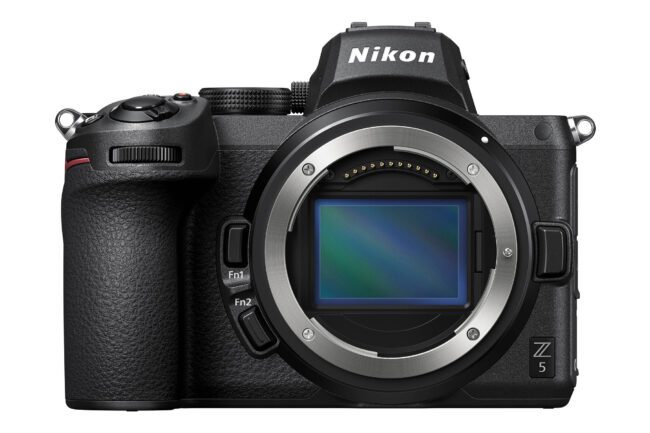
- Announced: July 2020
- Sensor size: FX
- Resolution: 24.3 megapixels
- Autofocus system: 273-point hybrid PDAF
- Frame rate: 4.5 FPS
- Base ISO: 100
- LCD type: Tilting touchscreen
- Max video specs: 3840×2160 (4k), 30p, but with a 1.7x crop
- Battery life: 470 photos
- Control layout: Advanced
- Memory cards: 2 SD (UHS-II compatible)
- Weight w/ battery and card: 675 g (1.49 lbs)
- Dimensions (W×H×D): 134 × 101 × 70 mm (5.3 × 4.0 × 2.8 in.)
- Price at launch: $1400; check current price
The Z5 is the least expensive full-frame Nikon Z camera at the moment, and it’s a really excellent value. Even though the starting price is $1400, I’ve seen it go on sale for $1000 at times (body only) which isn’t much more expensive than a DX camera.
It lacks the high frame rate of most Nikon Z cameras and uses a slightly older generation 24.3 megapixel sensor, but it still has excellent full-frame image quality. The Nikon Z5 is our top recommendation for first-time Nikon Z shooters on a budget. It’s much better to get this camera with a good lens than a more expensive camera with a bad lens.
Read our Nikon Z5 review for more.

Nikon Z6
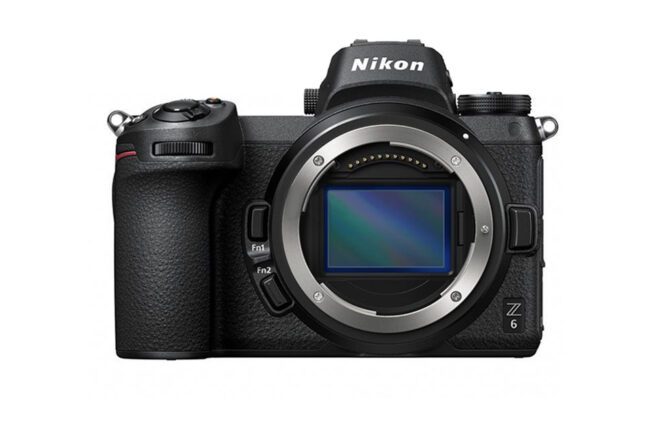
- Announced: August 2018
- Sensor size: FX
- Resolution: 24.5 megapixels
- Autofocus system: 273-point hybrid PDAF
- Frame rate: 12 FPS (12-bit RAW), 9 FPS (14-bit RAW)
- Base ISO: 100
- LCD type: Tilting touchscreen
- Max video specs: 3840×2160 (4k), 30p
- Battery life: 310 photos
- Control layout: Professional
- Memory cards: 1 XQD
- Weight w/ battery and card: 675 g (23.8 oz)
- Dimensions (W×H×D): 134 × 101 × 68 mm (5.3 × 4.0 × 2.7 in.)
- Price at launch: $1800; check current price
The Nikon Z6 (along with the Z7) was the first Z-series camera ever announced, back in August of 2018. It still has very impressive specifications today, including up to 12 FPS shooting and Nikon’s newest 24.5 megapixel sensor. However, it’s showing its age in a few areas, hence the release of a Nikon Z6 II in late 2020. It still makes for a great budget camera, especially because the used prices have fallen to excellent levels in recent years.
Read our Nikon Z6 review for more.

Nikon Z7
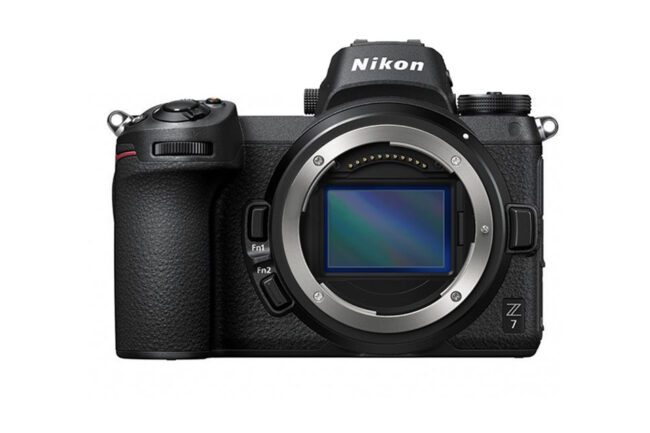
- Announced: August 2018
- Sensor size: FX
- Resolution: 45.7 megapixels
- Autofocus system: 493-point hybrid PDAF
- Frame rate: 9 FPS (12-bit RAW), 8 FPS (14-bit RAW)
- Base ISO: 64
- LCD type: Tilting touchscreen
- Max video specs: 3840×2160 (4k), 30p
- Battery life: 330 photos
- Control layout: Professional
- Memory cards: 1 XQD
- Weight w/ battery and card: 675 g (23.8 oz)
- Dimensions (W×H×D): 134 × 101 × 68 mm (5.3 × 4.0 × 2.7 in.)
- Price at launch: $3000; check current price
Announced alongside the Nikon Z6, the Nikon Z7 is a very similar camera in almost every way, except it has a higher resolution sensor (45 megapixels rather than 24) and a lower base ISO (64 rather than 100). The point of these changes is to allow for the highest possible image quality if using the camera with a sharp lens. However, if you’re happy with 24 megapixels and ISO 100, you can get practically the identical camera for hundreds of dollars less by buying the Z6 instead. (The Z6 even has a faster frame rate of 12 FPS rather than 9 FPS to boot.)
Read our Nikon Z7 review for more.
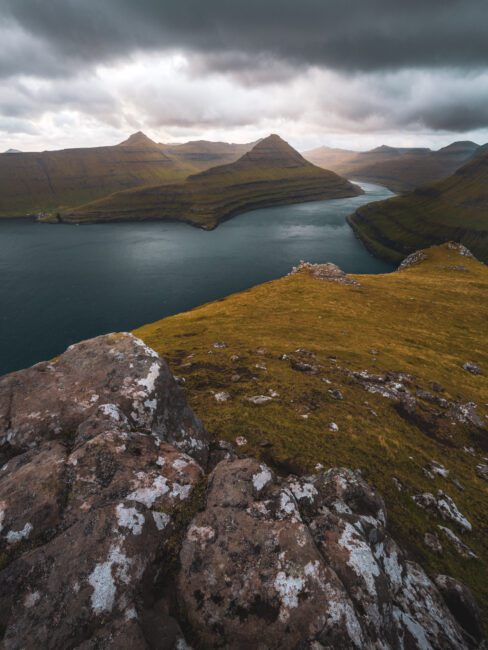
Nikon Z6 II
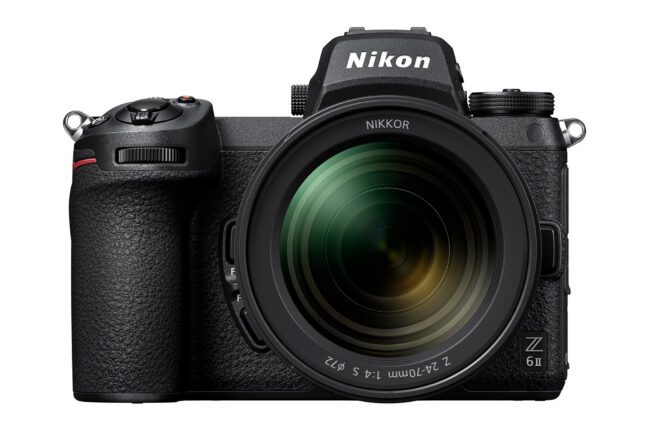
- Announced: October 2020
- Sensor size: FX
- Resolution: 24.5 megapixels
- Autofocus system: 273-point hybrid PDAF
- Frame rate: 14 FPS (12-bit RAW), 10 FPS (14-bit RAW)
- Base ISO: 100
- LCD type: Tilting touchscreen
- Max video specs: 3840×2160 (4k), 60p
- Battery life: 340 photos
- Control layout: Professional
- Memory cards: 1 CF Express, 1 SD (UHS-II compatible)
- Weight w/ battery and card: 705 g (1.55 lbs)
- Dimensions (W×H×D): 134 × 101 × 70 mm (5.3 × 4.0 × 2.8 in.)
- Price at launch: $2000; check current price
The Nikon Z6 II fixes some of the biggest complaints about the first-generation Z6. The biggest changes are the addition of a second memory card slot, a higher frame rate, and 4K 60p video recording. It also has plenty of smaller, behind-the-scenes fixes that I appreciate, like the option for a clutter-free display in live view and a fix for the Z6’s oversensitive eye sensor for the viewfinder. But because the Z6 II is fairly new, it’s more expensive than the Z6 these days, especially if you’re willing to buy the Z6 used. So, it’s all about what improvements you’re willing to pay for or not.
Read our Nikon Z6 II review for more.
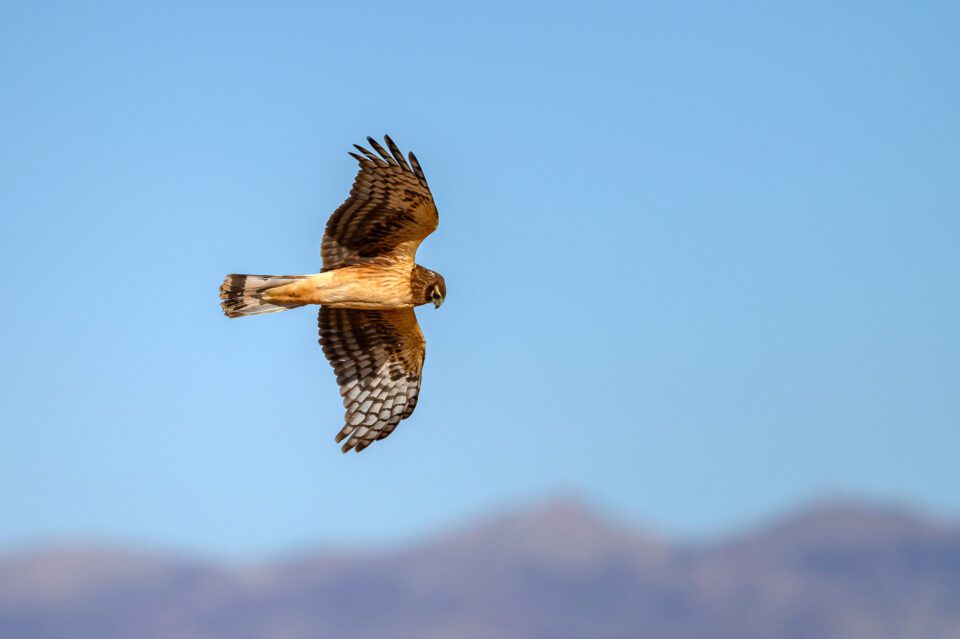
Nikon Z7 II
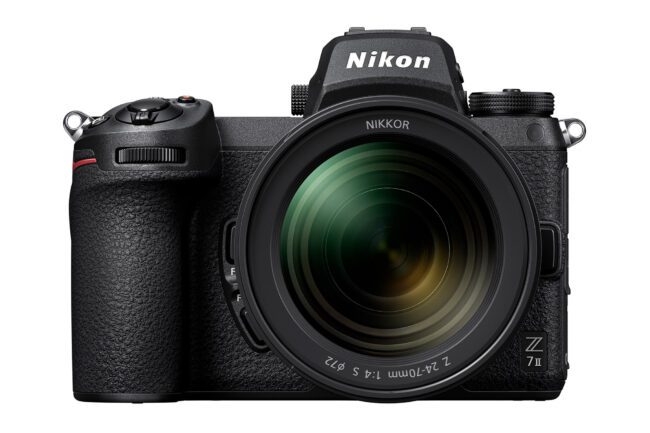
- Announced: October 2020
- Sensor size: FX
- Resolution: 45.7 megapixels
- Autofocus system: 493-point hybrid PDAF
- Frame rate: 10 FPS (12-bit RAW), 9 FPS (14-bit RAW)
- Base ISO: 64
- LCD type: Tilting touchscreen
- Max video specs: 3840×2160 (4k), 60p
- Battery life: 360 photos
- Control layout: Professional
- Memory cards: 1 CF Express, 1 SD (UHS-II compatible)
- Weight w/ battery and card: 705 g (1.55 lbs)
- Dimensions (W×H×D): 134 × 101 × 70 mm (5.3 × 4.0 × 2.8 in.)
- Price at launch: $3000; check current price
Rounding out the group is the Nikon Z7 II – no surprise, a camera that mimics the Z6 II’s improvements but for the Z7. The Nikon Z7 II has dual memory card slots, 4K 60p video, and a higher frame rate. It also has those same behind-the-scenes fixes I mentioned a moment ago. The only major differences between the Z6 II and Z7 II are frame rate (in favor of the Z6 II), base ISO (in favor of the Z7 II), high ISO performance (in favor of the Z6 II), and resolution (in favor of the Z7 II, if you don’t mind the larger files).
Read our Nikon Z7 II review for more.

Nikon Z9
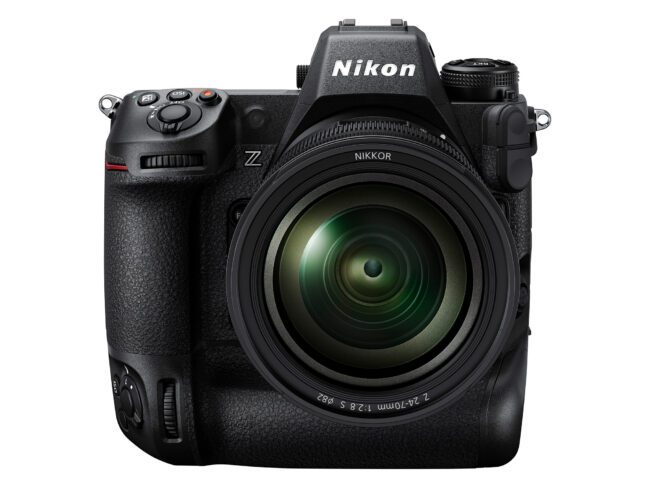
- Announced: Not yet! Scheduled for late 2021
- Sensor size: FX
- Max video specs: 8K video
- Control layout: Top tier professional
Although there are lots of rumored specifications for the Nikon Z9, the few details above are all that Nikon has officially confirmed. Some photographers have been spotted using the Nikon Z9 during the Tokyo Olympics, and Nikon has released a photo of the front of the camera to keep us on our toes.
Other than that, we’ll have to wait and see.
Nikon Z-Series Lenses
DX Lenses
Nikon’s DX lenses have a smaller image circle intended for DX cameras like the Z50 and Zfc. These lenses can still technically mount on the FX cameras, although your camera will automatically crop all your photos 1.5x when you do so, in order to avoid black corners. In general, I recommend using these lenses only on a DX camera.
- DX 16-50mm f/3.5-6.3 VR: A standard kit lens covering the usual wide to slight telephoto focal lengths, but in an extremely lightweight package. We were more impressed with this lens than we expected, and even though there are better Nikon Z lenses out there, this one is a good introduction to the system. $300 at release; check current price. Can be $160 cheaper when bought as a kit with a camera. See our 16-50mm f/3.5-6.3 review for more.
- DX 50-250mm f/4.5-6.3 VR: A lightweight telephoto DX zoom to complement the 16-50mm kit lens. It’s also not optically perfect but works surprisingly well and gets the job done. $350 at release; check current price. Can be $150 cheaper when bought as a kit with a camera. See our 50-250mm f/4.5-6.3 review for more.
FX Lenses
Nikon’s FX lenses have a larger imaging circle that covers the entire full frame (FX) camera sensor. They also mount on Nikon’s DX cameras without any issues. In fact, we encourage Nikon DX users to consider these lenses, since the dedicated DX lineup is somewhat limited at the moment.
- 14-24mm f/2.8: One of the best ultra-wide angle lenses we’ve ever tested at Photography Life. It has no significant optical flaws at all, and it’s very light for the type of lens at 650 g / 1.43 pounds. It takes native 112mm filters that attach via the HB-97 lens hood. $2200 at release; check current price. See our 14-24mm f/2.8 review for more.
- 14-30mm f/4: Nikon’s other ultra-wide Z-series zoom. It’s lighter, smaller, and less expensive than the 14-24mm f/2.8, and it takes standard 82mm filters. Our tests showed that it’s optically a very good lens but not at the otherworldly level of the 14-24mm f/2.8 S. $1300 at release; check current price. See our 14-30mm f/4 review for more.
- 20mm f/1.8: All of Nikon’s Z-series primes that we’ve tested have been outstanding in image quality, although most of them are more expensive than their F-mount counterparts (and most are about the same weight or slightly heavier). The 20mm f/1.8 S is no exception; it’s remarkably sharp and has almost no coma, making it an excellent choice for astrophotography. $1050 at release; check current price. See our 20mm f/1.8 review for more.
- 24mm f/1.8: Similar to the Nikon Z 20mm f/1.8 in optical performance – which is to say, almost flawless. If you’re choosing between these two lenses, the most meaningful difference is which focal length you prefer: 20mm or 24mm. $1000 at release; check current price. See our 24mm f/1.8 review for more.
- 24-50mm f/4-6.3: The most middling optical quality of the full-frame Nikon Z lenses at the moment. It’s an inexpensive, ultralight lens, so it does have an audience, but we tend to recommend other options instead if you’re willing to spend a bit extra. $400 at release; check current price. Can be $100 cheaper if bought as a kit with a camera. See our 24-50mm f/4-6.3 review for more.
- 24-70mm f/2.8: Nikon’s highest-end midrange zoom. In many ways, it continues what the Nikon Z 14-24mm f/2.8 S started: excellent performance with a constant f/2.8 aperture to capture a lot of light. It’s noticeably heavier and more expensive than Nikon’s other Z-series midrange zooms, though. $2300 at release; check current price. See our 24-70mm f/2.8 review for more.
- 24-70mm f/4: The first Nikon Z lens ever released; a kit lens that beats almost all other kit lenses. While this lens does have a few optical issues compared to the 24-70mm f/2.8 S, it’s much lighter and less expensive without falling too far behind. This lens (or the next one below) is our top recommendation for a Nikon Z shooter’s first piece of glass. $1000 at release; check current price. Can be $400 cheaper if bought as a kit with a camera. See our 24-70mm f/4 review for more.
- 24-200mm f/4-6.3 VR: The best superzoom we’ve ever tested – but still a superzoom. Nikon Z shooters who want maximum convenience and minimal weight should take a long look at the 24-200mm. Optically, it is the second weakest Nikon Z lens (only beating the 24-50mm) but it makes up for that in how useful it is. This is the lens I personally chose for my landscape and travel photography on the Nikon Z system, alongside the 14-30mm f/4. $900 at release; check current price. Can be $100 cheaper if bought as a kit with a camera. See our 24-200mm f/4-6.3 review for more.
- 28mm f/2.8: Although this lens has technically been released already, it is in very short supply and can only be bought as a kit with the Nikon Zfc (yes, even though this is an FX lens, and the Zfc is a DX camera). We have not yet had the opportunity to test it. However, it is very lightweight (160 g / 0.35 lbs) and inexpensive (eventually will sell for $300 on its own). If it holds its own optically, we will consider this to be one of the best “first lenses” for a Nikon Z shooter. Check current price and availability.
- 35mm f/1.8: One of the first Nikon Z lenses, and a very good one. It continues the trend of the 20mm f/1.8 and 24mm f/1.8 primes with excellent optical performance in almost every way. $850 at release; check current price. See our 35mm f/1.8 review for more.
- 50mm f/1.2: A high-end portraiture lens with a price and weight that match. Although this is one of Nikon’s sharpest lenses ever, it is a much more niche lens than the 50mm f/1.8 below. The large maximum aperture of f/1.2 lets in more than twice as much light as f/1.8, though. $2100 at release; check current price.
- 50mm f/1.8 Nikon’s mirrorless version of the “nifty fifty,” with modern optics and a higher price than usual. It’s not like this is a terribly expensive lens at $600, but compared to Nikon’s historical 50mm f/1.8 lenses (such as the $220 Nikon 50mm f/1.8G for the F-mount DSLR system), it does stand out a bit. It also stands out in image quality; this is one impressive lens. $600 at release; check current price. See our 50mm f/1.8 review for more.
- 50mm f/2.8 Macro: A macro lens with a so-so 50mm focal length but an ultralight design. We are currently testing this lens and will report our findings soon, but for Nikon Z shooters wanting a lightweight 50mm lens that can do close-ups, it’s a good one to consider. However, for true 1:1 macro photography, a 50mm lens isn’t going to be long enough for most photographers. You need to be very close to your subject, to the point that you’ll be blocking the light and potentially scaring it away. $650 at release; check current price.
- 58mm f/0.95: An ultra-niche manual focus prime lens with one of the fastest apertures on the market. This lens is not for the faint of heart. It’s 2000 g / 4.4 lbs and costs $8000. The f/0.95 maximum aperture lets in about 2/3 of a stop more light than an f/1.2 lens like Nikon’s 50mm f/1.2 S. It’s one of Nikon’s highest-end lenses ever with top tier optical quality. $8000 at release; check current price.
- 70-200mm f/2.8 VR: The single sharpest zoom lens we have ever tested – ideal for wildlife and sports photography. It completes the “f/2.8 trio” alongside the 14-24mm f/2.8 S and 24-70mm f/2.8 S.Nikon prioritized image quality more than weight with this lens (it’s about as heavy as the older F-mount 70-200mm f/2.8E for Nikon DSLRs). $2600 at release; check current price. See our 70-200mm f/2.8 review for more.
- 85mm f/1.8: Another stellar entry in Nikon’s f/1.8 prime lens lineup for the Z series. This lens is an excellent focal length for portraiture, and it can also double as a relatively small and lightweight telephoto for landscape photography thanks to its high sharpness. Pair this lens with any of the wider f/1.8 lenses for a good travel kit, too. $800 at release; check current price. See our 85mm f/1.8 review for more.
- 105mm f/2.8 Macro VR: A high-end macro photography lens with excellent image quality. It’s a bulkier lens than some photographers were hoping for, but it’s lighter than it looks, and it has few optical issues to complain about. We’re in the process of reviewing it right now. $1000 at release; check current price.
- 1.4x Teleconverter: A standard 1.4x teleconverter that does the job. At the moment, it’s only compatible with the Nikon Z 70-200mm f/2.8 VR and no other lenses. You lose one stop of light with this teleconverter, turning the 70-200mm f/2.8 into a 100-280mm f/4. It has a slight image quality penalty as well, but the 70-200mm is so sharp that you’ll hardly notice it. $550 at release; check current price.
- 2.0x Teleconverter: Similar to the other teleconverter, but with 2x increase in focal length (and a loss of two stops of light). It turns the 70-200mm f/2.8 into a 140-400mm f/5.6. This teleconverter has a bit more of an image quality penalty than the other but is still easily sharp enough for professional use. $600 at release; check current price.
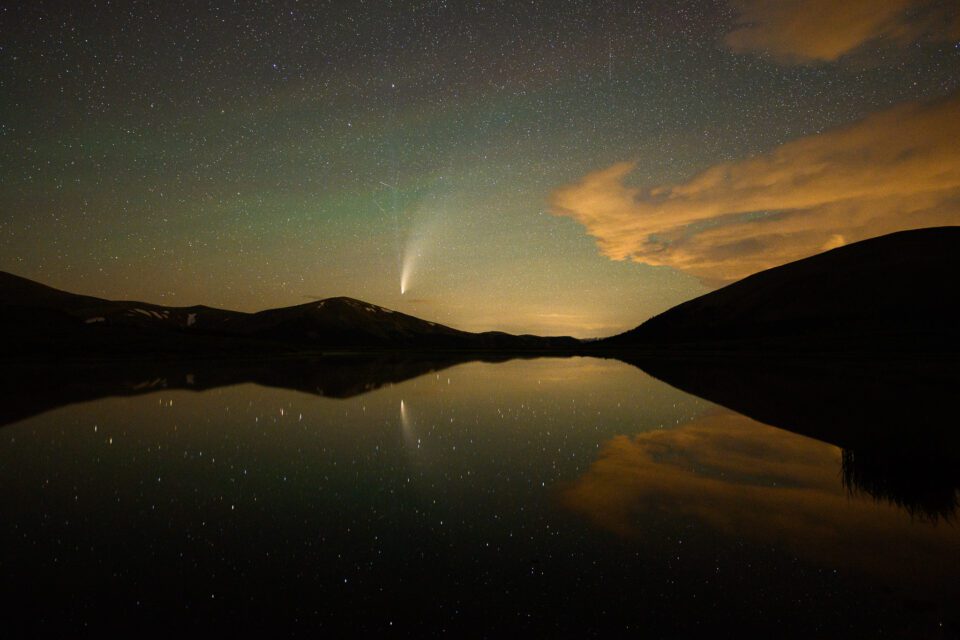
Unreleased Lenses
Thanks to Nikon’s mirrorless roadmap and a couple development announcements, we also have information about a few Nikon Z lenses that have yet to be released. Here are the lenses we know about.
- DX 18-140mm f/3.5-6.3 VR: A DX kit zoom that Nikon has pre-announced; will ship in 2021.
- 24-105mm S: No details known.
- 40mm f/2: A compact lens that Nikon has pre-announced; will ship in 2021.
- 85mm S: No details known, although the size of the lens in Nikon’s silhouette image implies it will be f/1.2.
- 100-400mm S: No details known.
- 200-600mm: No details known (except that it’s non-S-line; i.e., a slightly lower-end lens).
- 400mm S: No details known, but likely f/2.8. Either the 400mm S, the 600mm S, or both, will likely be released near the time of the Z9.
- 600mm S: No details known, but likely f/4. Either the 600mm S, the 400mm S, or both, will likely be released near the time of the Z9.
Nikon Z Official Accessories
Along with the cameras and lenses above, Nikon has some other products and accessories meant specifically for the Nikon Z system. Those are as follows:
- FTZ Adapter: A necessary accessory for photographers who want to use any Nikon F-mount DSLR lenses (of which there are hundreds available) on a Nikon Z camera. Even if you’re a first-time Nikon Z shooter, an FTZ adapter can expand the lenses at your disposal – everything from old manual focus gems to top-tier F-mount glass like the 28mm f/1.4E.
- MB-N10 Battery Grip: The least-loved accessory in Nikon’s lineup today. It’s a $200 battery pack with no special controls and very few features; it allows you to use up to two total EN-EL15 batteries on your Z camera at a time, roughly doubling your battery life. But most photographers would be better off bringing an extra battery or two in a pouch and saving some money (and weight). This grip is compatible with the Nikon Z5, Z6, Z7, Z6 II, and Z7 II.
- MB-N11 Battery Grip: A proper battery grip with vertical controls and the necessary connections to communicate with your camera. It costs $400 and is compatible with the Nikon Z6 II and Z7 II.
- Camera Straps: Nikon has designed a few camera straps for its Z cameras so far, and although they’re technically compatible with almost any camera on the market, the straps do say “Nikon Z” on them in big letters. The official strap for the Nikon Z5, Z6, Z7, Z6 II, and Z7 II is called the AN-DC19. The official strap for the Nikon Z50 is called the AN-DC20. And the official strap for the Nikon Zfc is called the AN-DC23.
- Bags: Nikon makes a couple bags that they market specifically for Nikon Z shooters, although obviously any camera that fits in the bag is perfectly compatible with it. The first is a shoulder bag called the Travel Kit (which comes in four colors: lemon, coral, sky, and charcoal). It costs $60 and is listed as compatible with only the Nikon Z50 and Zfc – though it’s certainly large enough for a Z6-sized-camera. The second bag, called the CF-DC9, is more like a small pouch that you may throw into a backpack for some padding. It costs $32 and is listed as compatible only with the Z5, Z6, Z7, Z6 II, and Z7 II – though it obviously fits the Z50 and Zfc as well.
- Batteries and Chargers: The Nikon Z50 and Zfc are the only two Nikon cameras at the moment to use the EN-EL25 battery. The charger for this battery is called the MH-32. The other Z-series cameras use EN-EL15 type batteries and the MH-25a charger.
- Video Kits: Two of the Nikon Z cameras so far have come as “creator kit” bundles with third-party video accessories. The first is the Nikon Z6, whose “Filmmaker’s Kit” ships with the Z6, Nikon Z 24-70mm f/4 S, Nikon FTZ adapter, Moza Air 2 gimbal, Moza Magic articulating arm, Rode VideoMic Pro+ microphone, Atomos Ninja V HDMI monitor, an extra EN-EL15b battery, a 1-year Vimeo subscription, and an online class on how to make music videos. The second is the Nikon Z50, which has a “Creator’s Kit” comprised of the Z50, Nikon DX 16-50mm f/3.5-6.3, Rode VideoMicro microphone, Joby GorillaPod 3K mini tripod, SmallRig Vlogging Mounting Plate, and Charcoal Nikon Travel Kit Bag. The Z6 kit costs $3800, and the Z50 kit costs $1150.
- Rubber Eyecup Replacements: The compatible eyecup for the Nikon Z5, Z6, Z7, Z6 II, and Z7 II is called the DK-29. The compatible eyecup for the Nikon Z50 is called the DK-30. The compatible eyecup for the Nikon Zfc is called the DK-32.
- Body Cap: The Nikon Z body cap is the BF-N1.
- Country-Specific Accessories: There are some specialized accessories only sold in a few countries (usually Japan) such as the Z-GR1 extension platform, a handgrip for the Nikon Zfc, and some specialized hotshoe covers.
There are also a number of lens-specific accessories such as replacement caps, cases, and lens hoods. You can find the full list here if you need a replacement.
I only included accessories in the list above if they are exclusively meant for Nikon Z cameras. Plenty of Nikon’s other accessories are compatible with the Z cameras as well as some DSLRs or point-and-shoot cameras. That list is below:
Remote Releases
- WR-1: Wireless radio remote controller; transmitter or receiver. Compatible with Z5, Z6, Z7, Z6 II, Z7 II. $643.
- WR-T10: Wireless radio remote shutter release; transmitter only. Compatible with Z5, Z6, Z7, Z6 II, Z7 II. $70.
- WR-R10: Wireless radio remote transceiver that pairs with WR-1 or WR-10. Compatible with Z5, Z6, Z7, Z6 II, Z7 II. $127.
- WR-R11b: Newer version of WR-R10. Wireless radio remote transceiver that pairs with WR-1 or WR-10. Compatible with Z5, Z6, Z7, Z6 II, Z7 II. $200.
- ML-L7: Bluetooth remote controller. Compatible with Z50 and Zfc. $50.
- MC-DC2: 1-meter long cord release. Compatible with Z5, Z6, Z7, Z6 II, Z7 II. $36.
Batteries and Chargers
- EN-EL15, 15a, 15b, and 15c: Batteries. Compatible with Nikon Z5, Z6, Z7, Z6 II, Z7 II. $50-73 depending on battery.
- EH-7P: AC adapter to charge EN-EL15b, EN-EL15c, and EN-EL25 batteries via USB. Compatible with all Nikon Z cameras except Z50. $60.
- EH-73P: AC adapter to charge Nikon EN-EL25 battery via USB. Compatible only with Z50. $40. Needs USB cable (such as $12 Nikon UC-E21, which is included with Z50) to charge.
- MH-25a: Standard charger for Nikon EN-EL15 type batteries. Compatible with Nikon Z5, Z6, Z7, Z6 II, Z7 II. $58.
Storage and Data Transfer
- Nikon 64 GB XQD: Memory card. Compatible with Nikon Z6, Z7, Z6 II, Z7 II. $130.
- WT-7A: Wireless and ethernet image transmitter, with camera control compatibility. Compatible with Nikon Z6, Z7, Z6 II, Z7 II. $935. Needs an EN-EL15 type battery for power.
Covers
- BS-1: Hotshoe cover. Compatible with all Nikon Z cameras. $2.
- BS-3: Hotshoe cover. Compatible with Z6 and Z7. $10.
Microphone
- ME-W1: Wireless mic system with transmitting microphone and receiver. Compatible with all Nikon Z cameras. $250.
- ME-1: Stereo microphone with power supplied by camera over mini-pin jack. Compatible with all Nikon Z cameras. $180.
Flash
- All Nikon Speedlites: Full compatibility with Nikon Z cameras.
- AS-15: Hotshoe to PC sync cord adapter to allow use with studio strobes. Compatible with all Nikon Z cameras. $28.
- SC-28: Remote cord with TTL capabilities. Compatible with all Nikon Z cameras. $81.
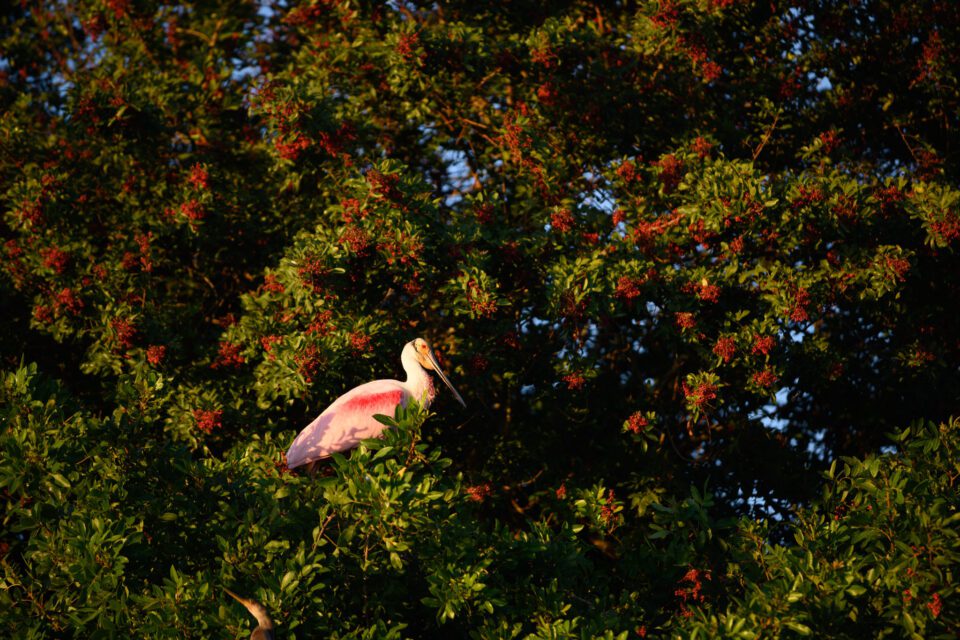
Conclusion
Turns out Nikon makes a lot of Z-series equipment! I did my best to make the guide above as comprehensive of a reference as possible, including the various useful accessories that Nikon Z shooters may be considering. If I missed anything, feel free to let me know in the comments and I’ll add it to the list. Likewise if you have any questions or comments – I’ll do my best to answer if you’re wondering about any of this gear.